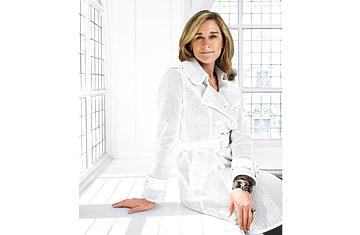
Blond, statuesque and wearing an elegantly draped megacheck cashmere scarf, Burberry CEO Angela Ahrendts looks as if she has just stepped out of a high-end fashion spread. Sitting in her London office, a few blocks from the Houses of Parliament, she dispels any suspicion that she might possess the haughty airs that can accompany such a glossy look.
"Isn't this a fabulous shoe?" she says, kicking out her left leg to present a Burberry wedge sandal with the brand's check pattern imprinted on the heel. "It looks even better on someone who doesn't wear a size 11."
Ask about élitism and exclusivity — the characteristics by which some luxury brands define themselves — and it becomes clear that the Indiana-born Ahrendts identifies more closely with the values of America's heartland than with those of the catwalk. "Just because you're a luxury brand doesn't mean you have to have an attitude," she says. "We don't want to be intimidating. We prefer to be inviting."
It's a quality the brand has displayed in spades in recent years. Founded in 1856, Burberry came to prominence during World War I when it produced trench coats for the British army that later became popular among civilians. By the 1990s, though, consumers perceived it as a dowdy raincoat company. But American Rose Marie Bravo, Ahrendts' predecessor, transformed the brand by linking it to celebrity, staging fashion shows and expanding product lines with items in the company's black-camel-white-and-red check. The company went public, sales more than doubled, and Burberry finally became a global fashion powerhouse.
That's a tough act to follow, but Ahrendts knew where to start. After taking the helm in July 2006, she shut down 35 product categories, mostly checked ones that had become overexposed, to boost the value of the iconic pattern. In order to grow an already growing business, Ahrendts plays the role of luxury Viking, expanding aggressively in 25 markets as diverse as China, Dubai, India and the U.S. So far, so good. Under her watch, revenues have risen more than 40%, to roughly $2 billion; profits have climbed 30%; and the number of Burberry stores and concessions has soared from 260 to 420 — with at least 10 more opening this year.
For Ahrendts, the road to high fashion started in New Palestine, Ind., where she grew up the third of six children. The daughter of a former model, she devoured fashion magazines, tracing and sketching the latest trends and dreaming that one day she could be the name behind them. A love of sewing — she first made clothes for her dolls and progressed to slinky tube dresses for herself — led Ahrendts to Ball State University. She quickly realized that other students had more raw talent for design. "But I had very strong opinions on everything they would do," she says. "A professor eventually sat me down and said, 'We call that a merchant.'"
In the summer of 1981, just one day after graduating, Ahrendts boarded a plane for New York City to jump-start a career in merchandising. Her keen eye for what consumers will buy led to her appointment as president of Donna Karan International in 1989, then executive vice president of Henri Bendel and later executive vice president of Liz Claiborne. At Liz Claiborne, Ahrendts oversaw mens- and women's-wear lines, which generated 40% of the company's total revenue. She also helped expand the portfolio from 10 brands to 41, championing hip but unheard-of start-ups like Juicy Couture — now a $500 million business — and Lucky Jeans.
Donna Karan says Ahrendts merges the left brain of a number cruncher with the right brain of an artist: "She knows how to balance a collection, taking into account the business needs while always protecting the integrity of the designer." Ahrendts credits Karan with helping her achieve that balance. "Donna lived in the design studio," she says. "She taught me that without a great product, you'll go nowhere."